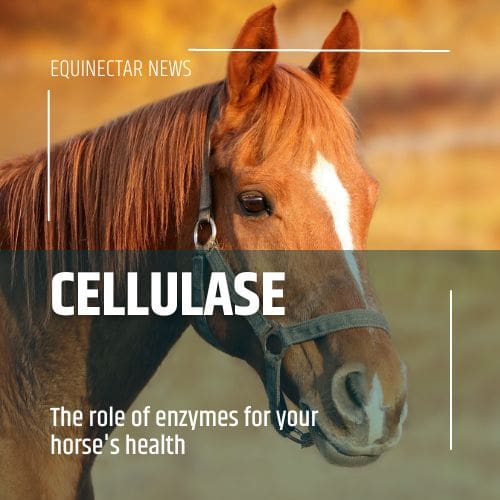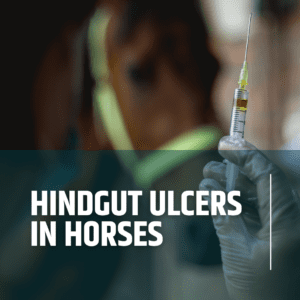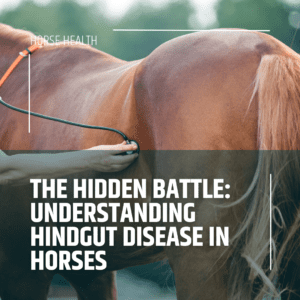What is the role of cellulase in a horse?
The role of cellulase in a horse is to break down complex sugars found in plant cell walls, such as cellulose, into simpler sugars that the horse can use for energy (1). This process aids in the digestion of forage and hay, which are major components of a horse’s diet. According to Glass (2016), by breaking down cellulose, cellulase helps the horse to extract energy from these plant-based feeds and maintain their overall health and well-being (1).
How do horses produce cellulase?
Horses produce cellulase in their hindgut, which is the portion of the digestive system located after the small intestine (2). When forage and hay pass through the horse’s digestive system, they reach the hindgut, where beneficial bacteria and other microorganisms produce cellulase to break down the complex sugars in the plant cell walls (3). This process releases simple sugars that the horse can use for energy and helps to support the growth and proliferation of beneficial bacteria in the hindgut microbiome (2).
How could supplementary cellulase help a horse’s digestion?
Supplementary cellulase can help a horse’s digestion by providing additional enzymes to break down the complex sugars in plant cell walls. This can aid in the digestion of forage and hay, which are important sources of energy for horses. In cases where a horse may have a deficiency in their own production of cellulase, supplementary cellulase can help to support their digestive health. Many studies on potential benefits of exogenous digestive enzyme supplementation in ruminants have been done (4). These studies demonstrate that supplementing ruminant diets with xylanase and cellulase can enhance overall digestibility, particularly for neutral detergent fibre (NDF) and acid detergent fibre (ADF) in faeces (5).
Can cellulase help support a healthy microbiome in horses?
Yes, cellulase can help support a healthy microbiome in horses. The microbiome is the community of bacteria and other microorganisms that live in the horse’s hindgut. By breaking down complex sugars in plant cell walls, cellulase helps to support the growth and proliferation of beneficial bacteria in the microbiome. This can help to maintain a balanced and healthy gut microbiome, which is essential for the horse’s digestive health and overall well-being (6). Additionally, cellulase supplementation might contribute to reducing the numbers of less beneficial bacteria in the hindgut.
Does EquiNectar contain cellulase?
Yes. The cellulase within EquiNectar comes from the sprouting barley grain that is the key ingredient in EquiNectar. It is a natural source of cellulase.
References:
[1] Glass N. L. (2016). The Enigmatic Universe of the Herbivore Gut. Trends in biochemical sciences, 41(7), 561–562. https://doi.org/10.1016/j.tibs.2016.05.007
[2] Julliand, V. & Grimm, P. (2017). The Impact of Diet on the Hindgut Microbiome. Journal of Equine Veterinary Science, 52, 23-28. https://www.sciencedirect.com/science/article/pii/S073708061630716X?casa_token=4wunL_Jq6mMAAAAA:9XaNSSB01CXhNPSQXoO2hQF8rizIG90fyO6teGUwdldHEl3SQIQYgah8z68tybrxFHrryuk9ew
[3] Vitalize. (2023, September 20). Understanding Hindgut Fermentation in Horses. BioZyme. https://vitalizeeq.com/2023/09/20/understanding-hindgut-fermentation-in-horses/
[4] Robinson, C., Nielsen, B., & Morris, R. (2007). Cellulase Supplementation Does Not Improve the Digestibility of a High-Forage Diet in Horses. Journal of Equine Veterinary Science, 27(12), 535-538. https://doi.org/10.1016/j.jevs.2007.10.014
[5] Rode, L., Yang, W., & Beauchemin, K. (1999). Fibrolytic Enzyme Supplements for Dairy Cows in Early Lactation. Journal of Dairy Science, 82(10), 2121-2126. https://doi.org/10.3168/jds.S0022-0302(99)75455-X
[6] Weinert-Nelson, J. & Williams, C. (2023, August). The Equine Hindgut Microbiome. New Jersey Agricultural Experiment Station. https://njaes.rutgers.edu/e375/





